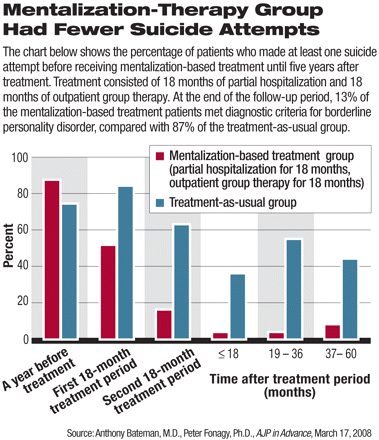Mentalization based therapy (MBT) is a specific type of psychodynamically-oriented psychotherapy designed to help people with borderline personality disorder (BPD). Its focus is helping people to differentiate and separate out their own thoughts and feelings from those around them.
People with borderline personality disorder tend to have unstable and intense relationships, and may unconsciously exploit and manipulate others. They may find it difficult or impossible to recognize the effects their behavior has on other people, to put themselves in other people’s shoes and to empathize with others.
Mentalization is the capacity to understand both behavior and feelings and how they’re associated with specific mental states, not just in ourselves, but in others as well. “ Mentalization” is the ability to perceive the mind of others as distinct from one's own and hence to reconsider and reassess one's own perceptions of reality. It is theorized that people with borderline personality disorder (BPD) have a decreased capacity for mentalization. Mentalization is a component in most traditional types of psychotherapy, but it is not usually the primary focus of such therapy approaches.
In mentalization-based therapy (MBT), the concept of mentalization is emphasized, reinforced and practiced within a safe and supportive psychotherapy setting. Because the approach is psychodynamic, therapy tends to be less directive than cognitive-behavioral approaches, such as dialectical behavior therapy (DBT), another common treatment approach for borderline personality disorder.
In someone with BPD, the difference between the person’s inner experience and the perspective given by the therapist (or others), as well as the person’s attachment to the therapist (or others), often leads to feelings of bewilderment and instability.
Unsurprisingly, this leads to more, rather than less, problems in the person’s life. It has been proposed that people with BPD have hyperactive attachment systems as a result of their history or biological predisposition, which may account for their reduced capacity to mentalize. They would be particularly vulnerable to side-effects of psychotherapeutic treatments that activate the attachment system.
Yet without activation of the attachment system, people with BPD will never develop a capacity to function in a healthy manner in the context of interpersonal relationships.
Mentalization, like socialization or public speaking, is a skill which can be readily learned. People who undergo MBT will find that their therapy experience focuses on learning and practicing this skill in the context not only of their social relationships with others, but also directly with their therapist.
